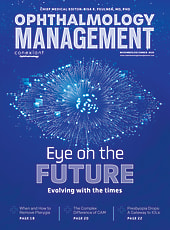Presbyopia. It’s a term we use daily in ophthalmology, but for many patients, it marks an unexpected and frustrating turning point. What feels like a natural part of aging to us often feels like a sudden loss of independence to them. Just yesterday, they could read menus, messages, and fine print with ease—today, they’re reaching for reading glasses.
As treatment options for presbyopia continue to evolve—from innovative eye drops to advanced intraocular lens (IOL) technology—our role as leaders is to ensure that our teams are well-informed, confident, and equipped to support patients with empathy and accuracy. Presbyopia is more than just a diagnosis; it’s a chance to build trust and guide patients through one of the most common and relatable vision changes they’ll experience.
Understanding the Treatment Landscape
Presbyopia management has never been more dynamic. Gone are the days when reading glasses were the only solution. While readers still play an important role in magnification (and we never diminish their value), today's treatment options offer patients more freedom and flexibility than ever before.
Let’s explore the key categories your staff should understand:
Presbyopia-Correcting Eye Drops
New pharmaceutical solutions, such as pilocarpine-based drops, offer short-term improvement in near vision by reducing pupil size and increasing depth of focus. These drops are ideal for patients who want to minimize their dependence on readers for specific tasks without pursuing surgical correction.
While these treatments are exciting, it’s important for staff to understand their limitations and properly communicate expectations. The effects are temporary, results vary, and not all patients are good candidates—particularly those with concerns about night vision or preexisting retinal conditions.
Clarity in messaging is key. Patients might assume these drops are a permanent fix. Staff should be comfortable explaining that while drops can be helpful, they’re part of a broader toolkit—not a standalone solution.
IOL Technology
Advancements in IOL technology have expanded our ability to address presbyopia during cataract surgery or refractive lens exchange. Today’s lenses are designed with different visual goals and patient lifestyles in mind.
We categorize these technologies into:
1. Multifocal IOLs
Multifocal IOLs offer multiple focal points to improve distance, intermediate, and near vision. They’re a great fit for patients seeking a high degree of spectacle independence, though they may experience visual phenomena such as halos or glare.
2. Extended Depth of Focus (EDOF) IOLs
These IOLs provide a continuous range of vision with fewer visual disturbances, often appealing to patients who prioritize intermediate tasks like computer use. Near vision may be less pronounced than with multifocal lenses, so setting expectations is essential.
3. Light Adjustable Lenses (LALs)
A true game-changer, Light Adjustable Lenses (LAL; RxSight) offer customization after surgery through UV light treatments, allowing fine-tuning of the visual outcome. LALs are particularly well-suited for patients who want greater control and are committed to the postoperative adjustment process.
Monovision LASIK/PRK
For patients who aren’t ready for lens-based solutions, monovision LASIK or PRK can be an effective choice. This approach corrects one eye for distance vision and the other for near vision, helping reduce dependence on glasses. However, monovision isn’t for everyone—some patients may struggle to adapt to the difference in focus between the eyes. Careful patient selection is essential, and a monovision contact lens trial beforehand is often recommended to determine whether a patient can comfortably tolerate the correction before moving forward with surgery.
Despite these innovations, one message needs to remain consistent across our entire team: no technology can promise total freedom from glasses. Our goal with treatment is to reduce their reliance—not eliminate it entirely. What we aim to deliver is clear, functional vision that supports the majority of their everyday activities, with the understanding that some tasks may still require readers.
Staff Education and Training
No matter how advanced the technology, patient satisfaction often comes down to the clarity, confidence, and consistency of the information they receive from your team. Staff are on the frontlines of education, reassurance, and expectation management. That’s why training is essential—and it needs to start early. At Chu Vision Institute, we prioritize presbyopia education within the first few weeks of onboarding, especially for clinical staff who have direct patient interactions. What follows are several examples of how we train our staff on presbyopia to ensure consistent, confident communication at every step of the patient journey.
Create a Culture of Learning
Make presbyopia education a priority in team meetings and training sessions. Review emerging technologies, revisit patient FAQs, and real patient scenarios. Encourage open dialogue so staff feel comfortable asking questions. The more they understand, the more they can confidently communicate with patients.
Practice Everyday Conversations
Staff are often on the frontlines of patient education. They field questions like “What’s the best lens?” or “Will I still need glasses?” Practice scenarios that help staff navigate those questions with empathy and accuracy. Equip them with phrasing like:
“Most patients find they can do the majority of their daily activities without glasses, though you may still need them for certain tasks.”
“These drops can offer flexibility, but they’re not a permanent solution.”
Help staff strike a balance between optimism and realism. Patients appreciate transparency, especially when it’s paired with enthusiasm about what’s possible.
Designate Champions
Assign team members to take the lead in each treatment category. These ‘champions’ stay current on clinical updates, help train new staff, and provide extra support when complex patient questions arise. Champions can also share insights from the clinic to help leadership identify training gaps or workflow improvements.
Train Beyond the Clinical Team
Remember, every staff member influences the patient experience—even those not directly involved in clinical care. Front desk, call center, and billing teams all field questions and help shape first impressions. Provide these team members with the right language and high-level understanding so they feel confident and aligned in their messaging.
Setting the Right Expectations Together
We are fortunate to have a growing number of options to help patients manage presbyopia. But with more options comes the responsibility to guide patients thoughtfully. Clear, consistent communication from every touchpoint builds trust and reduces confusion.
Presbyopia may be frustrating for patients, but with the right tools and team, we can make their journey smoother and more empowering. It starts with education—not just for patients, but for every member of your practice.
Presbyopia isn’t new—but the way we treat it has changed dramatically. As we continue to embrace these advancements, let’s also commit to the one constant that always makes a difference: a well-trained, well-informed team. When staff feel confident in the technology and comfortable guiding patients, they elevate the entire care experience.
Let’s stay curious, keep learning, and lead our teams to be ambassadors of both innovation and patient-centered care. OP









